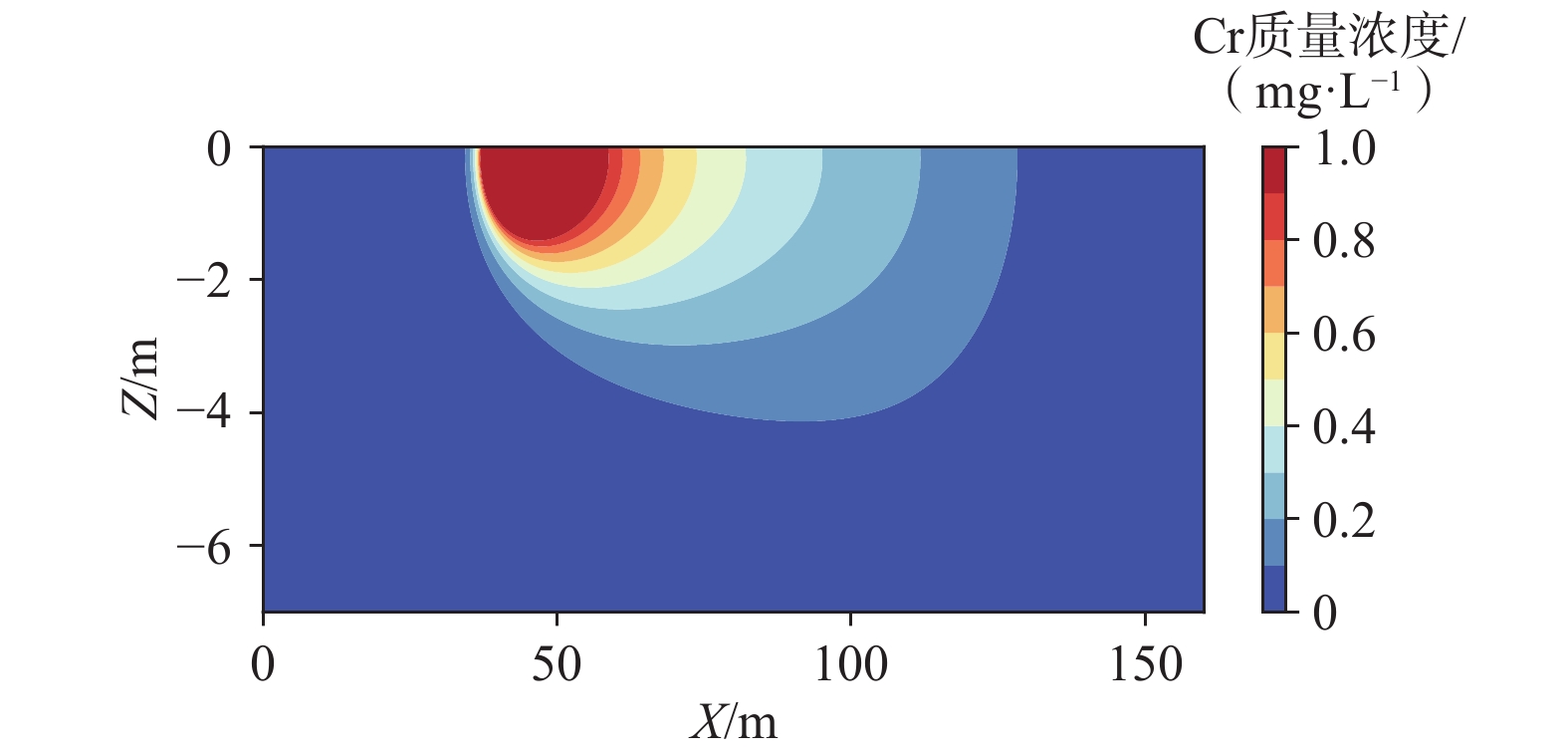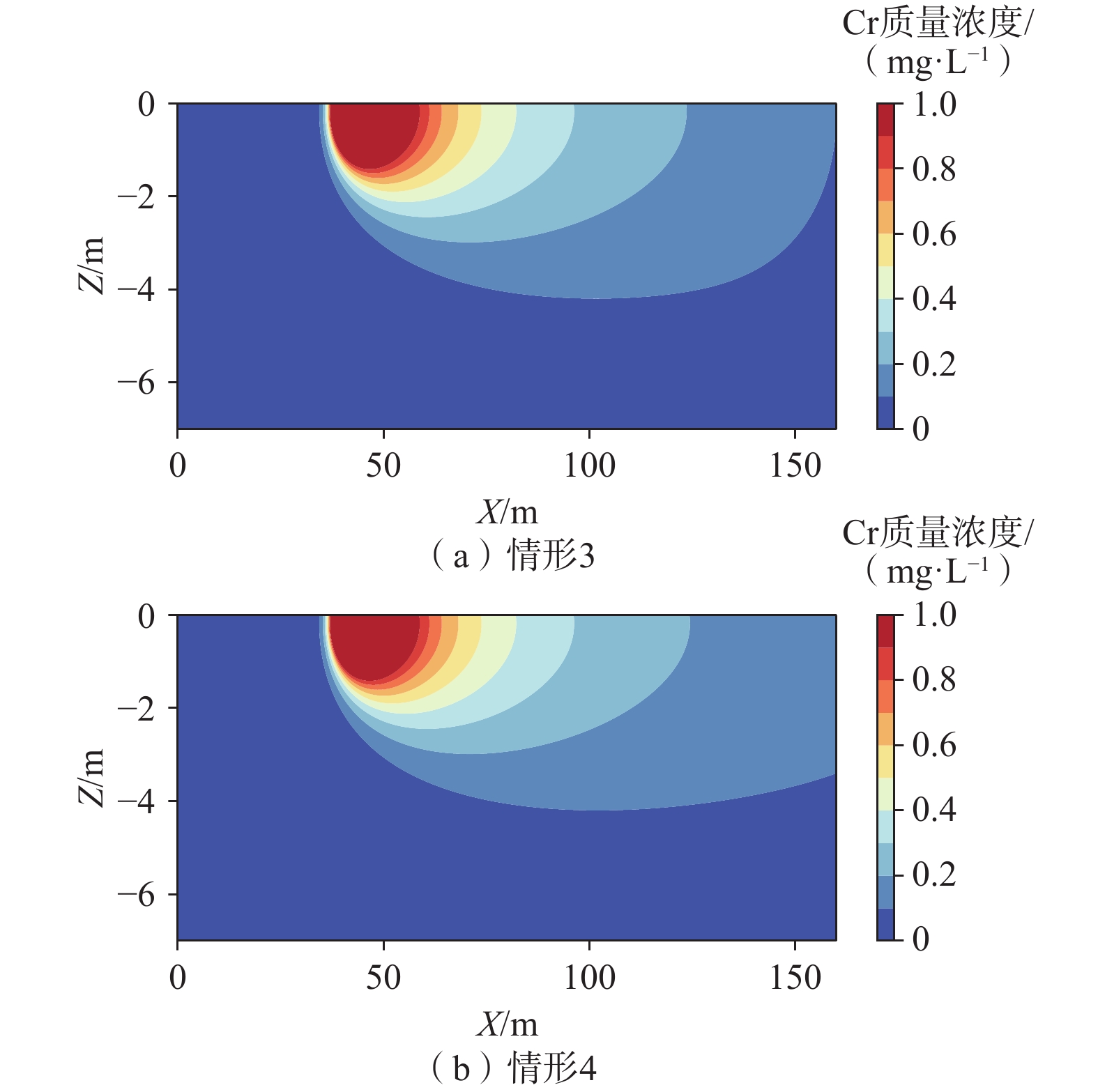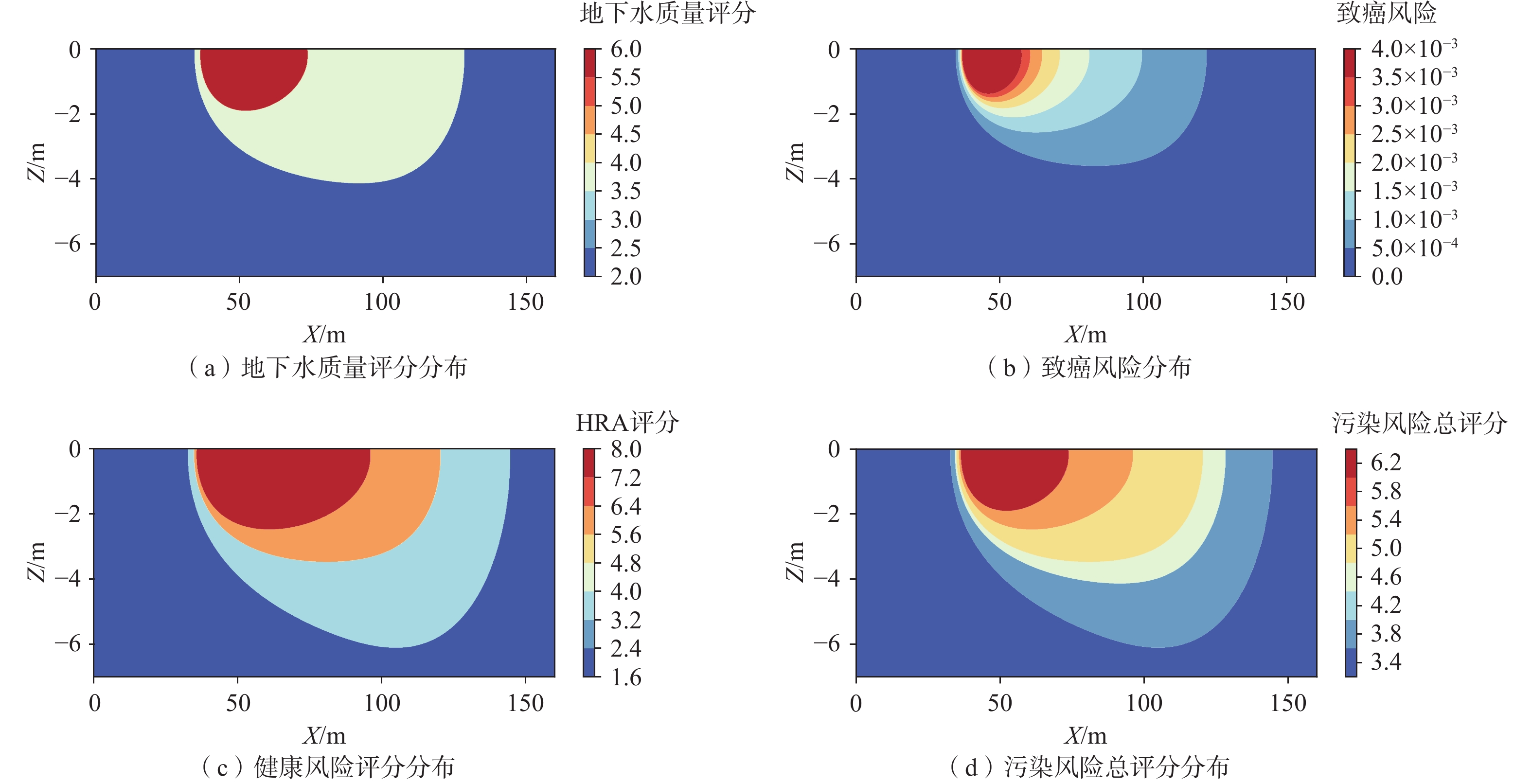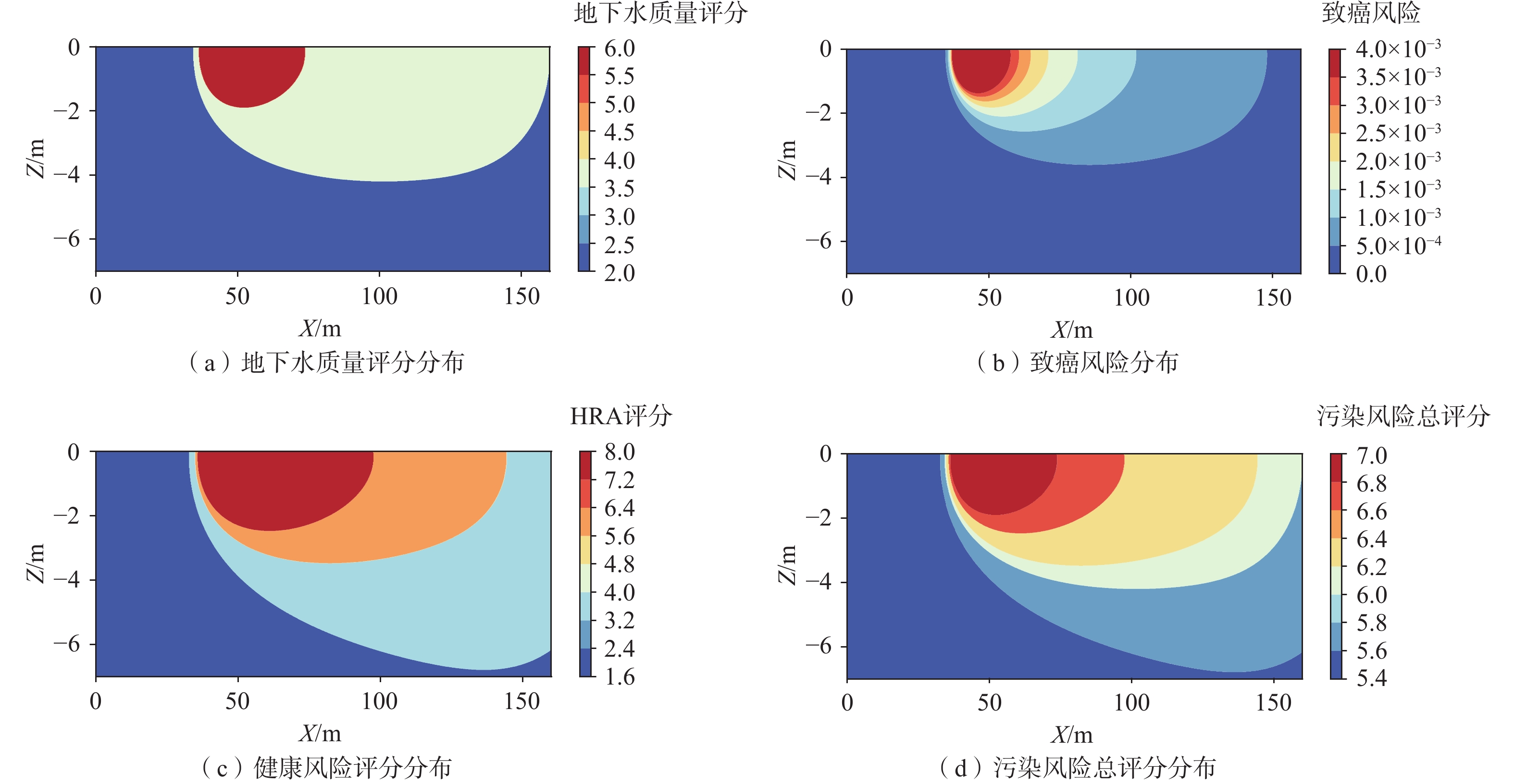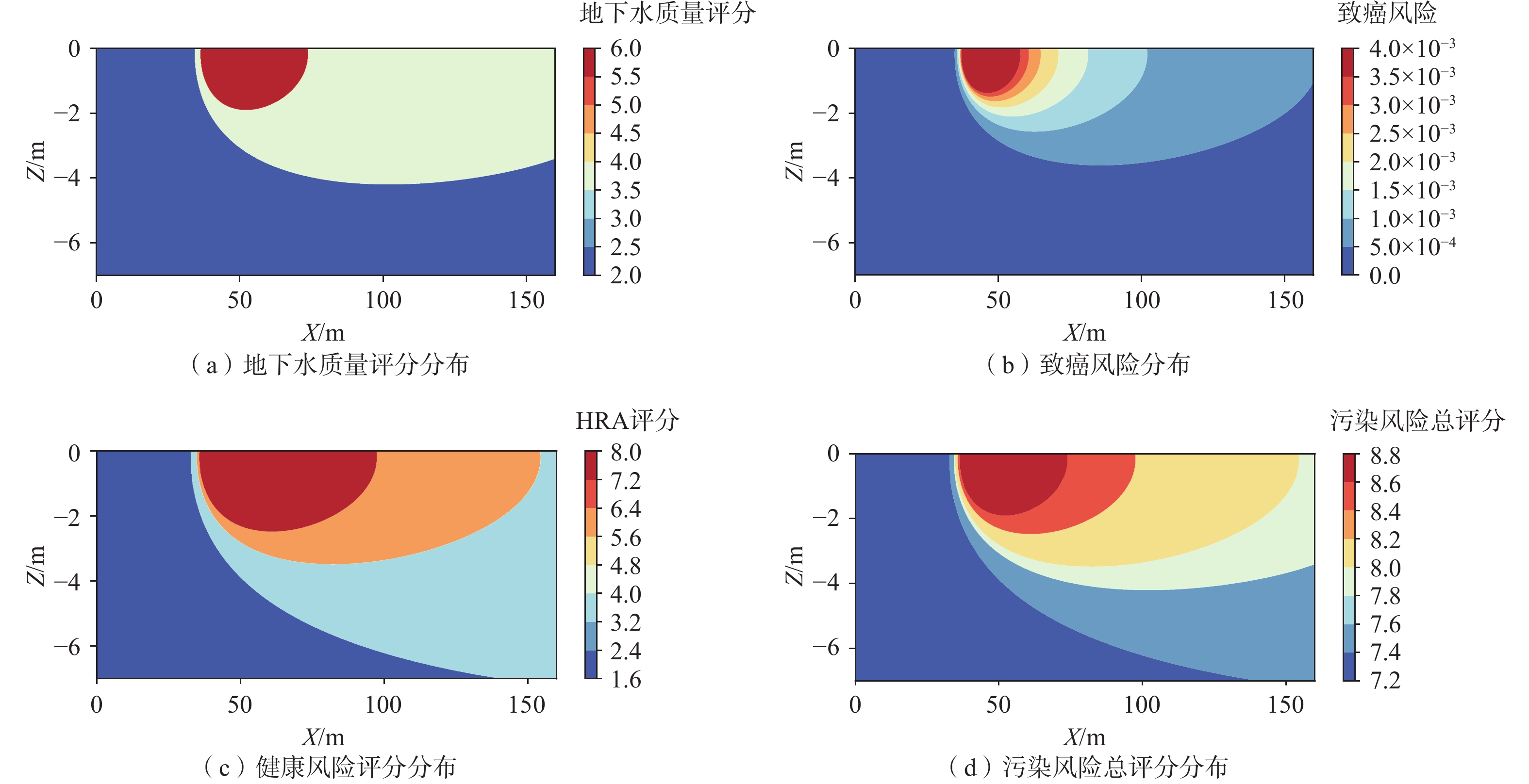A study of the multi-tiered risk assessment method of site groundwater contamination considering transport-induced risk
-
摘要:
地下水中污染物具有迁移性和扩散性,会对下游敏感受体造成威胁,目前场地地下水风险评估主要关注人体健康风险,还未能综合考虑地下水污染的整体风险,尤其是忽视了污染物迁移引起的对下游敏感受体的风险。本研究基于“源-径-汇”模型构建了考虑污染物扩散风险的场地地下水污染风险评估的指标体系与风险评估模式。在指标体系构建方面,重点考虑场地地下水的污染源、迁移路径和敏感受体3个方面。在风险评估模式方面,根据场地不同地下水污染状态开展3个层次的风险评估。基于假想的铬污染场地开展了案例分析,设置了地下水污染状态的4种情景,利用Wexler溶质运移模型计算了地下水污染羽的时空变化,并针对地下水污染的不同层次开展了风险评估。结果表明,在场地地下水污染羽未到达场地边界的2种情形中,场地地下水的风险评分分别为4.0,6.2,分别属于低风险与中风险。在场地地下水污染羽到达或超出场地边界的2种情形中,场地地下水的风险评分分别为7.0,8.8,分别属于中风险与高风险。综合而言,本研究构建的方法能够用来对场地地下水进行系统全面的评估和对比,能够根据风险结果对污染场地进行有效的分级管控,为污染场地的风险管控提供技术支撑。
Abstract:Contaminants in groundwater can spread downstream, causing risks to receptors along the path. The risk assessment of our current site groundwater contamination focuses mainly on human health risks. It rarely considers integrated risks of groundwater contamination, particularly neglecting risks to recepters at downstream locations. This study constructs a new index system and a tiered risk assessment approach for site groundwater contamination based on the “source-pathway-receptor” model considering risks to downstream receptors. For the construction of the index system, the source, pathway and receptor of site groundwater contamination are considered. For the risk assessment approach, a multi-tiered risk assessment are determined according to site groundwater contamination status. Based on the hypothetical case study of a chromium-contaminated site, four scenarios of groundwater contamination states are set. The spatio-temporal changes of groundwater contamination plumes are calculated by using the Wexler solute transport model, and risk assessment is carried out for different states of the groundwater contamination. The results show that in the two cases where the site groundwater contamination plumes have not reached the site boundary, the risk scores of the site groundwater are 4 and 6.2 points, respectively. The risk of the site groundwater at the two contamination states is low and medium, respectively. In the two cases where the site groundwater contamination plumes have arrived or exceeded the site boundary, the risk scores of the site groundwater are 7.0 and 8.8 points, respectively. The corresponding risk at the two contamination states is medium and high, respectively. It can be seen that this new method can comprehensively assess the potential level of harm of groundwater contamination to both human health and ecological environment, and therefore can provide technical support for the management of contaminated sites.
-

-
表 1 指标分级评分
Table 1. Index grading table
土壤污染物入渗浓度 土壤污染范围 地下水质量 健康风险 敏感受体或使用
功能类型迁移至敏感受体
的天数/d迁移速度
/(m·d−1)赋值 符合IV类水水质目标 0~5%调查范围 符合水质目标 CR≤10−6且HQ≤1 其他类型或没有敏感受体 T>1000 v≤0.3 2 超IV类水水质目标
0~5倍>5%~10%调查范围 超水质目标0~5倍 10−6<CR≤5×10−6或
1<HQ≤5建设用地 500<T≤1000 0.3<v≤1 4 超IV类水水质目标
>5~20倍
>10%~25%调查范围超水质目标>5~20倍 5×10−6<CR≤10−5或
5<HQ≤10居住用地 250<T≤500 1<v≤2 6 超IV类水水质目标
>20~50倍>25%~50%调查范围 超水质目标>20~50倍 10−5<CR≤10−4或
10<HQ≤100工农业用水 100<T≤250 2<v≤5 8 超IV类水水质目标
>50倍>50%调查范围 超水质目标>50倍 CR>10−4或
HQ>100水源地和敏感地表水体 T≤100 v>5 10 表 2 多层次风险评估模式
Table 2. Multi-level risk assessment model
指标层次 地下水含水层污染特征 指标组合 第一层次 未污染(场地土壤已污染) 源 第二层次 已污染,范围未超场界 源、径、汇 第三层次 已污染,范围已超场界 源、径、汇 -
[1] 张保会,王林芳,郭宏,等. 我国污染场地修复决策系统研究进展[J]. 环境与可持续发展,2021,46(2):138 − 143. [ZHANG Baohui,WANG Linfang,GUO Hong,et al. Progress of the research on the decision system of contaminated site restoration in China[J]. Environment and Sustainable Development,2021,46(2):138 − 143. (in Chinese with English abstract)
[2] 车均,张蕾. 地下水污染控制与修复的研究[J]. 资源节约与环保,2014(3):136. [CHE Jun,ZHANG Lei. Study on groundwater pollution control and remediation[J]. Resources Economization & Environmental Protection,2014(3):136. (in Chinese with English abstract) doi: 10.16317/j.cnki.12-1377/x.2014.03.096
[3] 中华人民共和国生态环境部. 建设用地土壤污染风险评估技术导则: HJ 25.3—2019[S]. 北京: 中国环境环境科学出版社, 2019
Ministry of Ecology and Environment of the People’s Republic of China. Technical guidelines for risk assessment of soil contamination of land for construction: HJ 25.3—2019[S]. Beijing: China Environment Publishing Group, 2019. (in Chinese)
[4] 王超,李辉林,胡清,等. 我国土壤环境的风险评估技术分析与展望[J]. 生态毒理学报,2021,16(1):28 − 42. [WANG Chao,LI Huilin,HU Qing,et al. Analysis and prospects on soil environmental risk assessment technology in China[J]. Asian Journal of Ecotoxicology,2021,16(1):28 − 42. (in Chinese with English abstract)
[5] 董敏刚,张建荣,罗飞,等. 我国南方某典型有机化工污染场地土壤与地下水健康风险评估[J]. 土壤,2015,47(1):100 − 106. [DONG Mingang,ZHANG Jianrong,LUO Fei,et al. Health risk assessment of soil and groundwater for A typical organic chemical contaminated site in Southern China[J]. Soils,2015,47(1):100 − 106. (in Chinese with English abstract) doi: 10.13758/j.cnki.tr.2015.01.016
[6] 苏安琪,韩璐,晏井春,等. 基于保护健康和水环境的氯代烃类污染场地地下水风险评估[J]. 环境工程,2018,36(7):138 − 143. [SU Anqi,HAN Lu,YAN Jingchun,et al. Risk assessment of chlorinated solvents in groundwater based on health and water environment[J]. Environmental Engineering,2018,36(7):138 − 143. (in Chinese with English abstract) doi: 10.13205/j.hjgc.201807028
[7] 雷廷. 基于溶质运移的地下水有机污染健康风险评价方法研究[D]. 北京: 中国地质科学院, 2014
LEI Ting. Research on health risk assessment method of organic pollution in groundwater based on solute transport[D]. Beijing: Chinese Academy of Geological Sciences, 2014. (in Chinese with English abstract)
[8] 中华人民共和国生态环境部. 地下水污染健康风险评估工作指南: 环办土壤函[2019]770号[S]. 2019
Ministry of Land and Resources of the People’s Republic of China. Guidelines for health risk assessment of groundwater pollution: [2019]770[S]. 2019. (in Chinese)
[9] 骆永明,滕应. 中国土壤污染与修复科技研究进展和展望[J]. 土壤学报,2020,57(5):1137 − 1142. [LUO Yongming,TENG Ying. Research progresses and prospects on soil pollution and remediation in China[J]. Acta Pedologica Sinica,2020,57(5):1137 − 1142. (in Chinese with English abstract)
[10] USEPA. addition of a subsurface intrusion component to the hazard ranking system: 40 CFR 300[S]. Washington: Federal Register, 2017.
[11] CCME. National classification system for contaminated sites[R]. Winnipeg: Canadian Council of Ministers of the Environment, 2008.
[12] DARMENDRAIL D. The French approach to contaminated-land management. Revision 1[EB/OL]. France: BRGM, 2003(2007-12-31)[2022-10-30]. http://infoterre.brgm.fr /rapports/RP-52276-FR.pdf.
[13] 徐亚,刘景财,刘玉强,等. 基于Monte Carlo方法的污染场地风险评价及不确定性研究[J]. 环境科学学报,2014,34(6):1579 − 1584. [XU Ya,LIU Jingcai,LIU Yuqiang,et al. Quantification of uncertainty in evaluating the health risk of a contaminated site based on Monte Carlo method[J]. Acta Scientiae Circumstantiae,2014,34(6):1579 − 1584. (in Chinese with English abstract)
[14] 国家质量监督检验检疫总局, 中国国家标准化管理委员会. 地下水质量标准: GB/T 14848—2017[S]. 北京: 中国标准出版社, 2017
General Administration of Quality Supervision, Inspection and Quarantine of the People’s Republic of China, Standardization Administration of the People’s Republic of China. Standard for groundwater quality: GB/T 14848—2017[S]. Beijing: Standards Press of China, 2017. (in Chinese)
[15] 中华人民共和国生态环境部. 饮用水水源保护区划分技术规范: HJ 338—2018[S]. 北京: 中国环境环境科学出版社, 2018
Ministry of Ecology and Environment of the People’s Republic of China. Technical guidelines for delineating source water protection areas: HJ 338—2018[S]. Beijing: China Environmental Science Press, 2018. (in Chinese)
[16] 刘玲,陈坚,牛浩博,等. 基于FEFLOW的三维土壤-地下水耦合铬污染数值模拟研究[J]. 水文地质工程地质,2022,49(1):164 − 174. [LIU Ling,CHEN Jian,NIU Haobo,et al. Numerical simulation of three-dimensional soil-groundwater coupled chromium contamination based on FEFLOW[J]. Hydrogeology & Engineering Geology,2022,49(1):164 − 174. (in Chinese with English abstract) doi: 10.16030/j.cnki.issn.1000-3665.202102008
[17] SANGANI J,SRIVASTAVA A,SRINIVASAN V. Analytical solutions to three-dimensional reactive contaminant transport problems involving point,line,and area sources[J]. Transport in Porous Media,2022,144(3):641 − 667. doi: 10.1007/s11242-022-01828-x
[18] SUÁREZ-SOTO, ANDERSON, MASLIA, et al. A comparison between BIOCHLOR and the analytical contaminant transport analysis system (ACTS) for a case study in coastal Georgia[C]//World Environmental and Water Resources Congress 2008. Reston: American Society of Civil Engineers, 2008: 1 − 10.
[19] WEXLER E J. Analytical solutions for one-, two-, and three-dimensional solute transport in ground-water systems with uniform flow[M]. Denver, CO: Dept. of the Interior, U. S. Geological Survey, 1989.
[20] 王嘉瑜,蒲生彦,胡玥,等. 地下水污染风险预警等级及阈值确定方法研究综述[J]. 水文地质工程地质,2020,47(2):43 − 50. [WANG Jiayu,PU Shengyan,HU Yue,et al. Review on the determination methods for early warning grade and threshold of groundwater pollution risk[J]. Hydrogeology & Engineering Geology,2020,47(2):43 − 50. (in Chinese with English abstract) doi: 10.16030/j.cnki.issn.1000-3665.201907044
[21] 中华人民共和国生态环境部. 污染地块土壤环境管理办法(试行)[EB/OL].(2016-12-31). [2022-09-02]. https://www.mee.gov.cn/gkml/hbb/bl/201701/t20170118_394953.htm.
Ministry of Ecology and Environment of the People’s Republic of China. Measures for soil environment management of contaminated land plots (Trial)[EB/OL]. (2016-12-31). [2022-09-02]. https://www.mee.gov.cn/gkml/hbb/bl/201701/t20170118_394953.htm. (in Chinese)
-




 下载:
下载:
